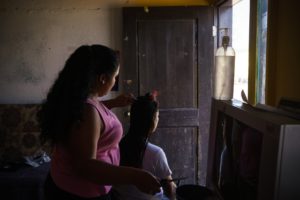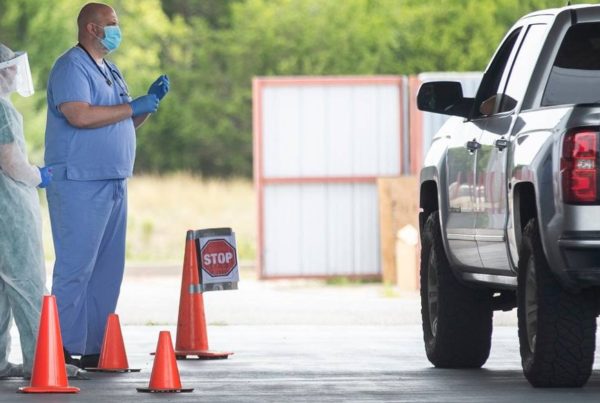From KERA:
Cinthia remembers the first time it happened.
On a chilly morning in March, she bundled up her 6-year-old son and went to an international bridge between Juárez and El Paso, ready to appear in court. But asylum proceedings had been canceled. Crestfallen, Cinthia joined a long line of asylum seekers waiting to get a new court date from U.S. officials.
Her son noticed people breezing by them, freely crossing the bridge, and asked where they were going.
“To the U.S.,” Cinthia recalled telling him.
“Why can’t we cross like that?” he asked. She explained that they have to wait for permission.
“Like right now we’re getting permission from Mexico to be here,” she told him. “We need permission to be here, or otherwise they’d send us back to Honduras. Now we have to wait for permission to be in the U.S.”
They’re two of thousands of people seeking asylum in the U.S., waiting in Mexico for their day in U.S. immigration court under the Trump administration’s “Remain in Mexico” policy, formally known as the Migrant Protection Protocols, or MPP.
The policy has faced sharp criticism and several legal challenges. The U.S. Supreme Court recently agreed to hear a case concerning MPP sometime this fall.
We’re not using Cinthia’s and other migrants’ full names in this story because they are in the middle of immigration proceedings and fear sharing information could affect the outcome of their cases.

Cinthia styles a friend’s hair at Pan de Vida Migrant Shelter in Ciudad Juárez on Sept., 6, 2020.
Paul Ratje For KERA
Cinthia hasn’t told her son why they left Honduras — about the gang she says killed two of her siblings, then came after her. She doesn’t want to scare him. So she tells him they’re moving closer to family, since his grandfather lives in America.
When her son asks why they can’t go home, why they’re spending so long in a shelter, she shows him videos of the U.S. to get him excited about being there.
But with courts closed due to COVID-19, Cinthia can’t give him a timeline for when they’ll cross into the country. Her March hearing, she said, was rescheduled for August. Then August came, and she received a new date: Feb. 3, 2021.
Some migrants have applied for asylum in Mexico.
Cinthia says that doesn’t feel like an option. Juárez is too dangerous a place for migrants, and she doesn’t have family or connections in other parts of the country.
“Imagine it, just grabbing my son and going somewhere.” Cinthia said. “Where? In the U.S. you have a cousin, a relative, who will extend a hand. Who will give you a place to go. Help you get a job. But here you don’t have anyone to say, ‘come, you can stay in my house.’ You don’t have anyone. It’s really hard.”
Cinthia’s U.S. immigration hearing — just one of several steps in the asylum process — has now been delayed by almost a year. It’s like this for most people under the “Remain in Mexico” policy.
Waiting at the bridge
“There are several people who’ve had their courts rescheduled three to four times up until now,” said Taylor Levy, an immigration attorney based in El Paso.
For months, Levy spent her mornings at the base of the Paso del Norte international bridge. When asylum seekers showed up for court, she gently broke the news that hearings were postponed. This is not an official part of her job; she just felt someone should be there, to tell people what was going on before they received new court dates from immigration officials.
These interactions often took place while it was still dark; migrants with 9 a.m. court hearings were instructed to arrive at the bridge by 4:30 in the morning.
The conversations could be heartbreaking, Levy said, especially with families who came for their final hearings, thinking it was their last day in Mexico.
She remembers one little boy, about eight years old, who showed up in a full suit, lugging a big suitcase behind him.
“I had to break it to his mom, who just burst into tears hearing that there wasn’t going to be court, that it wasn’t their final date,” she said.
These postponements would have been devastating no matter what, but Levy doesn’t think it had to be this way. She thinks, when the pandemic began, the federal government should have paroled asylum seekers into the U.S. — allowing them to shelter with relatives or other sponsors while they waited for court to reopen.
Instead, Levy said, they’re stuck for even longer in dangerous conditions.
No timeline for hearings

Will Rocci of Seguimos Adelante talking with a boy inside a group home in Pan de Vida Migrant Shelter in Ciudad Juárez on Sept. 24, 2020.
Paul Ratje For KERA
In July, the federal government laid out its plans for resuming asylum hearings for those in MPP. There are detailed criteria states on both sides of the U.S.-Mexico border must meet for court proceedings to be considered safe. Mexican border states like Chihuahua must achieve “yellow” status, while states like Texas must reach Phase 3 of their reopening plans.
At this point in the pandemic, hitting those benchmarks seems far away.
“There’s so many people right now who are just stuck in complete purgatory,” said Will Rocci, co-founder of Seguimos Adelante, one of the few nonprofits still providing direct, on-the-ground support to asylum seekers in Juárez during the pandemic.
“They’re stuck in spatial purgatory and they’re stuck in legal purgatory. They’re not in the place they want to be, but they can’t go back to where they were.”
That desperation has driven some to give up on the legal process. Some have returned to their home countries. Others have attempted to cross the border again, without getting caught.

Levis, an asylum seeker from Honduras who was placed in the “Remain in Mexico” program, is pictured with her son in Pan de Vida Migrant Shelter in Ciudad Juárez on Aug. 26, 2020.
Paul Ratje For KERA
It’s difficult to know how many people have given up waiting in places like Juárez.
Levis, a Honduran asylum seeker KERA interviewed for this series, said she has considered that option. Her asylum hearing was rescheduled for April 2021.
“I’m not going to lie,” she said. “I’ve thought about trying to cross another way.”
Levis’ husband and one of their daughters are already in the U.S.; they fled Honduras first, and arrived before the Trump administration implemented “Remain in Mexico.”
Now, the family is separated by a thin slice of the Rio Grande and one of the Trump administration’s signature immigration policies.
Levis has been staying at the Pan de Vida shelter for more than a year with her three other children, who range in age from 5 to 14.
“All of us here despair,” she said. “Imagine being shut in for a year in this place without being able to leave,” for fear of being kidnapped or killed.

Levis, an asylum seeker from Honduras who was placed in the “Remain in Mexico” program, is pictured with her son in Pan de Vida Migrant Shelter in Ciudad Juárez on Aug. 26, 2020. Paul Ratje For KERA
“We’re living as prisoners in this place,” she continued. “It’s been a year since my kids have been able to go out somewhere — to a park, to have fun, to be happy again. It’s not life, what we have here.”
But Levis said she has to weigh different risks. She knows crossing the desert is dangerous; her little boy and two daughters might not make it through alive.
She became emotional as she spoke, wiping tears from her face. Her son, who had been playing outside, came in to cool off and climbed up into her lap. He wrapped a small arm around her neck and pressed his cheek against hers.
For now, Levis said, she is choosing to wait here, and trying to create small moments of joy for her children when she can.
Her youngest turned four on their journey to the U.S. border; there was no real opportunity to celebrate. So she recently organized a big, dinosaur-themed party for his fifth birthday, at the shelter.
A talented artist, she made construction-paper T-Rexes and Velociraptors, then pasted them onto the wall — a beautiful, hand-crafted mural.
“He’s gone a long time without being happy,” she said. “I want him to have a special day.”
She hopes their situation changes before her next child’s birthday. Her eldest daughter will turn 15 in April. Levis wants to throw her a true quinceañera, outside the shelter, reunited with family.
Mallory Falk is a corps member with Report For America, a national service program that places journalists into local newsrooms. Got a tip? Email Mallory at Mfalk@kera.org. You can follow Mallory on Twitter @MalloryFalk.














